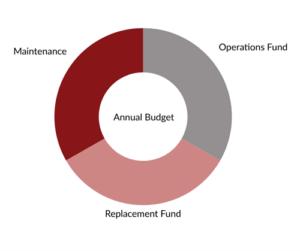Before I dive in, let me be clear: my decades as an architect and my career as a Reserve Specialist didn’t make me a guru in Community Association Budgets. But, by “looking in from the outside,” I’ve spotted some interesting budgeting aspects that might just be helpful to those of you “on the inside.”
Early in our community association involvement, we were taught that an annual budget has two parts: the Operations & Maintenance Budget and the Replacement Reserve Budget. While this has been the accepted practice for years, I think it’s more useful to view these as three separate components: Operations, Maintenance, and Reserves. Each has its own specific purpose, and seeing them distinctly gives us a fresh perspective on their interrelated roles.
Lincoln “Linc” Cummings, one of the Founding Fathers of CAI, once shared with me that, at one time, all three “buckets” Operations, Maintenance, and Reserves—were housed in a single budget. The Replacement Reserves bucket was eventually separated, partly because it was tough to convince Association Members to contribute to the annual budget when there was already so much money sitting around.
The Corporate vs. Brick-and-Mortar Divide
Because of their separate and distinct functions, it’s crucial to view the Operations and Maintenance funds as separate. Think of it this way:
- The Operations Fund provides for the Corporate functioning of the Association.
- The Maintenance Fund provides for the Brick-and-Mortar (common elements) needs of the Association.
When reviewing the needs of the Corporate side, you’ll typically find things like utilities, management services, staffing, and consultants such as insurance specialists, CPAs, legal services, and reserve specialists. All these are essential for the smooth and effective operation of the corporate entity!
The Maintenance budget, on the other hand, includes the tasks needed to keep up the physical Brick-and-Mortar side of the Corporation. And the Replacement Reserve Funds are intended for the prompt replacement once those Brick-and-Mortar common elements have reached the end of their economic life.
The Missing Link: Technical Expertise for Your Assets
Too often, there’s a vital link missing between Operations and Maintenance. If we look at the consultants usually included in the Operations Budget, they often only focus on specialists who help run the Corporate side. What’s often excluded are the technical consultants needed to effectively manage the Brick-and-Mortar side of the association.
This includes architects, engineers (civil, structural, mechanical, etc.), lake and pond specialists, roofing and masonry consultants, and others. This omission is critical because the interrelationship of these three budget components depends on all three being appropriately funded.
If we’re not budgeting for the services that help us effectively maintain the Brick-and-Mortar common elements, we lack the necessary ability to determine if we’re budgeting too little, too much, or even if we’re spending the money wisely to get the best results. Ineffective maintenance practices often lead to shortened useful lives for common elements, which then causes increased Reserve Funding. This can result in otherwise unnecessary increases in annual assessments for our members/owners.
Reserve Studies vs. In-Depth Consultations: Don’t Confuse Them!
One final, crucial point: many Boards confuse the role of the Reserve Study with the role of more in-depth technical consultations. You’ll often hear, “We don’t need to hire that engineer because the Reserve Study will cover that!”
WRONG! A Reserve Study is based on visual observations and is not a substitute for more in-depth Architectural or Engineering studies or other technical consultations. This holds true for all types of associations! Even a small association with just an entrance sign and a stormwater pond needs these more in-depth examinations just as much as a large-scale association, townhouse, mid-rise, or high-rise condo.
By recognizing the separate yet interrelated functions of each, you can budget wisely for all three portions of your Association’s Annual Budget. I believe this approach will help us budget more wisely and effectively!
Written by Peter B. Miller, RS, an architect in his earlier career, has been conducting Reserve Studies for over 30 years. Peter previously served on the Board of Trustees of CAI National, and currently is a Co-Chair of the Reserve Study, Maintenance, and Building Safety Task Force, and is a member of the Foundation for Community Association Research (FCAR).
Are you looking to request a proposal for your community or facility now? Visit here!


